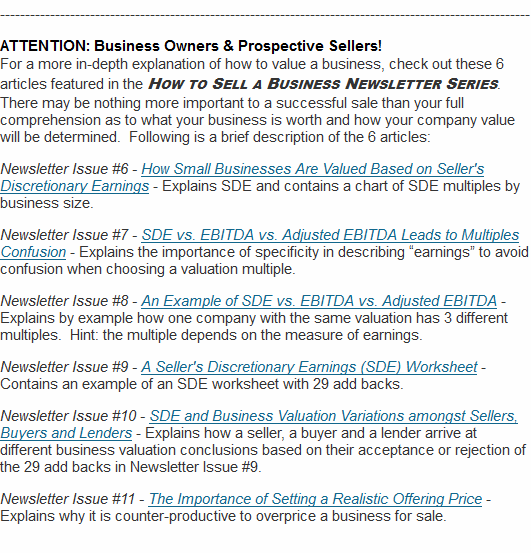Earnings Multiples for Small Business
Depending on their size, businesses are valued based on a multiple of earnings. But which earnings number is utilized? The earnings multiple for a small business is applied to seller’s discretionary earnings (SDE). The earnings multiple for larger businesses is applied to EBITDA. The approximate cutoff, although it can vary with circumstances, for our definition of a small business vs. a larger business is seller’s discretionary earnings of $1,000,000.
EBITDA is an acronym for Earnings Before Interest, Taxes, Depreciation and Amortization and is used for larger businesses. In general terms, Seller’s Discretionary Earnings is equal to EBITDA plus owner’s compensation and owner perks. SDE is an effort to identify all owner benefits available to the new owner of a business. Clearly, because SDE is a larger number than EBITDA, the earnings multiple applied to SDE is less than the earnings multiple applied to EBITDA.
An Example of Earnings Multiples for Seller’s Discretionary Earnings
and EBITDA
Here’s an example of how the two types of multiples are different for the same company. Let’s assume a business’ financial statement shows $500,000 of net income, income taxes of $150,000, interest expense of $25,000, depreciation of $100,000 and amortization of $10,000.These assumptions add up to EBITDA of $785,000. Now let’s also assume the owner’s salary is $200,000 and he receives an additional $15,000 in owner perks. Adding that $215,000 of adjustments to the $785,000 of EBITDA yields $1,000,000 of seller’s discretionary earnings. If you refer to the multiples chart for seller’s discretionary earnings in Newsletter Issue #6 - How Small Businesses Are Valued Based on Seller's Discretionary Earnings (SDE), you’ll see that the appropriate multiple for SDE of $1,000,000 is 4.0x. That means the approximate computed business valuation is $4,000,000 ($1,000,000 x 4.0). Theoretically, the value of the business shouldn’t be any different whether EBITDA or Seller’s Discretionary Earnings are used. So, let’s just back into the EBITDA multiple. The business value of $4,000,000 divided by EBITDA of $785,000 yields a multiple of 5.10x. The purpose of this paragraph is simply to explain the last sentence of the previous paragraph: "Clearly, because SDE is a larger number than EBITDA and each method should yield the same valuation, the earnings multiple applied to SDE is less than the earnings multiple applied to EBITDA."


Adjusted EBITDA and Add Backs
The example above is fairly simplistic. There are many other types of adjustments and add backs that must be considered. For instance, often Adjusted EBITDA is used to account for excess owner’s compensation (above fair market value to replace the owner’s services) or excess facility lease payments to an owner (when the owner personally owns the facility the business operates in). To see an example of Adjusted EBITDA read Adjusted EBITDA Calculation. To learn more about other addbacks read Add Backs for Business Valuation.
Charts of Earnings Multiples for Business Valuation
For a variety of reasons, the appropriate multiple to apply to earnings increases as EBITDA and/or SDE increases. The industry of the business being valued can also have an effect on the choice of an appropriate multiple. SDE multiples usually range from 1.0x to 4.0x. The range of EBITDA multiples (for EBITDA between $1,000,000 and $10,000,000) is 3.3x to 8x, with the averages ranging from 4.5x to 6.5x. To view a chart of multiples of seller’s discretionary earnings, read Newsletter Issue #6 - How Small Businesses Are Valued Based on Seller's Discretionary Earnings (SDE). For an EBITDA chart, read EBITDA Multiples by Industry.
For a more complete understanding of how to value a small business check out this article here: how to value a small business for sale. Another good article to consider if you're trying to get a value on your business is how to value goodwill when selling your business





